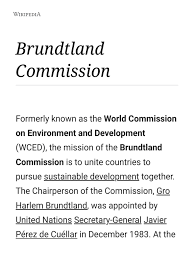“`html
The Brundtland Commission: Pioneering Sustainable Development
The Brundtland Commission, officially known as the World Commission on Environment and Development, was established by the United Nations in 1983. Named after its chair, former Norwegian Prime Minister Gro Harlem Brundtland, the commission played a pivotal role in shaping the concept of sustainable development.
One of the key achievements of the Brundtland Commission was the publication of its landmark report, “Our Common Future,” in 1987. This report defined sustainable development as “development that meets the needs of the present without compromising the ability of future generations to meet their own needs.”
The commission emphasized the interconnectedness of environmental protection, economic development, and social equity. It highlighted the importance of addressing global challenges such as climate change, biodiversity loss, and poverty through integrated and long-term strategies.
Through its work, the Brundtland Commission raised awareness about the urgent need for a more sustainable approach to development. Its recommendations influenced policies and initiatives at national and international levels, leading to greater emphasis on environmental conservation and social justice.
Today, the principles put forward by the Brundtland Commission continue to guide efforts towards a more sustainable future. The commission’s legacy serves as a reminder of the importance of balancing economic progress with environmental stewardship and social responsibility.
“`
Understanding the Brundtland Commission: Purpose, Pillars, and Impact
- What was the purpose of the Brundtland Commission?
- What are the 3 pillars of sustainability?
- What are the three pillars of Brundtland?
- What is significant about the Brundtland Report?
- What happened in the Brundtland Commission in 1987?
- What are the pillars of the Brundtland Commission?
What was the purpose of the Brundtland Commission?
“`html
The primary purpose of the Brundtland Commission, also known as the World Commission on Environment and Development, was to address the growing concern over the impact of human activities on the environment and society. Established by the United Nations in 1983, the commission aimed to promote sustainable development by advocating for policies that balance economic growth, environmental protection, and social equity. Through its influential report “Our Common Future” released in 1987, the commission defined sustainable development as meeting present needs without compromising the ability of future generations to meet their own needs. By highlighting the interconnectedness of environmental, economic, and social issues, the Brundtland Commission played a crucial role in shaping global discussions on sustainability and influencing policy decisions worldwide.
“`
What are the 3 pillars of sustainability?
“`html
The Brundtland Commission identified three pillars of sustainability, which are essential for achieving a harmonious balance between environmental protection, economic development, and social equity. These pillars include environmental sustainability, focusing on the conservation and preservation of natural resources; economic sustainability, emphasizing the need for responsible and inclusive economic growth that benefits all members of society; and social sustainability, promoting social justice, equality, and the well-being of present and future generations. By addressing these three interconnected pillars, sustainable development aims to create a more resilient and equitable world for all.
“`
What are the three pillars of Brundtland?
“`html
The Brundtland Commission, also known as the World Commission on Environment and Development, introduced the concept of sustainable development with three interconnected pillars: economic development, social equity, and environmental protection. These pillars represent the foundation for achieving a balanced and harmonious approach to development that meets the needs of present generations without compromising the ability of future generations to meet their own needs. By emphasizing the importance of addressing economic, social, and environmental concerns in an integrated manner, the Brundtland Commission laid the groundwork for a holistic approach to sustainable development that continues to guide global efforts towards a more equitable and environmentally sustainable future.
“`
What is significant about the Brundtland Report?
“`html
The significance of the Brundtland Report, also known as “Our Common Future,” lies in its pioneering definition and advocacy of sustainable development. Released in 1987 by the Brundtland Commission, the report introduced the concept of sustainable development as a framework for addressing environmental, economic, and social challenges. By emphasizing the importance of meeting present needs without compromising the ability of future generations to meet their own needs, the report sparked global awareness and action on sustainability issues. The Brundtland Report’s impact extends beyond its time, shaping policies and initiatives that promote a more balanced and equitable approach to development worldwide.
“`
What happened in the Brundtland Commission in 1987?
In 1987, a significant event took place within the Brundtland Commission when it released its seminal report titled “Our Common Future.” This report, a culmination of years of research and collaboration, defined the concept of sustainable development as meeting present needs without compromising the ability of future generations to meet their own needs. The publication of this report marked a pivotal moment in global discourse on environmental conservation, economic growth, and social equity, setting the stage for widespread recognition of the interconnectedness between these pillars and the necessity for integrated approaches to addressing pressing global challenges.
What are the pillars of the Brundtland Commission?
“`html
The Brundtland Commission, also known as the World Commission on Environment and Development, identified three pillars that form the foundation of sustainable development. These pillars are economic growth, social equity, and environmental protection. The commission emphasized the interconnectedness of these pillars, highlighting that sustainable development requires balancing economic prosperity with social well-being and environmental conservation. By addressing these three dimensions simultaneously, the Brundtland Commission sought to promote a holistic approach to development that meets the needs of present and future generations.
“`

